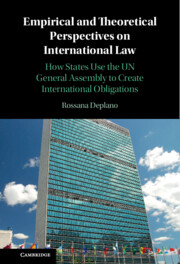 Empirical and Theoretical Perspectives on International Law
Empirical and Theoretical Perspectives on International Law Published online by Cambridge University Press: 21 July 2022
This chapter examines the different functions that resolutions serve in state submissions before international courts and tribunals. The analysis revolves around two interrelated issues. On the one hand, it discerns between instances in which states treat resolutions as evidence of state practice and instances in which states treat resolutions as the practice of the General Assembly. On the other hand, the analysis evaluates the extent to which states and judges hold different views on the legal significance of resolutions. It demonstrates that issues relating to the legal significance of resolutions revolve around a double dichotomy generated by the different positions taken by states and judges in relation to assertion and attribution of the source of the legal significance of resolutions to state practice or the separate will of the General Assembly. It contends that it is difficult, if not impossible, to generalize about the legal significance of resolutions given the character of international polyarchy of the General Assembly. It then offers insights into the concept of autonomy of the General Assembly from its member states.
To save this book to your Kindle, first ensure [email protected] is added to your Approved Personal Document E-mail List under your Personal Document Settings on the Manage Your Content and Devices page of your Amazon account. Then enter the ‘name’ part of your Kindle email address below. Find out more about saving to your Kindle.
Note you can select to save to either the @free.kindle.com or @kindle.com variations. ‘@free.kindle.com’ emails are free but can only be saved to your device when it is connected to wi-fi. ‘@kindle.com’ emails can be delivered even when you are not connected to wi-fi, but note that service fees apply.
Find out more about the Kindle Personal Document Service.
To save content items to your account, please confirm that you agree to abide by our usage policies. If this is the first time you use this feature, you will be asked to authorise Cambridge Core to connect with your account. Find out more about saving content to Dropbox.
To save content items to your account, please confirm that you agree to abide by our usage policies. If this is the first time you use this feature, you will be asked to authorise Cambridge Core to connect with your account. Find out more about saving content to Google Drive.